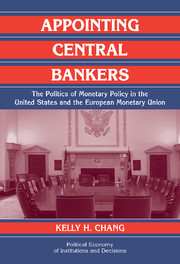 Appointing Central Bankers
Appointing Central Bankers Book contents
- Frontmatter
- Contents
- List of Figures
- List of Tables
- Acknowledgments
- 1 Introduction
- 2 A Formal Model of the Appointment Process
- 3 Estimating Monetary Policy Preferences
- 4 Empirically Testing the Model's Predictions
- 5 Appointments to the European Central Bank
- 6 The Origins of the Federal Reserve Appointment Process
- 7 Conclusions
- Bibliography
- Index
- Titles in the series
1 - Introduction
Published online by Cambridge University Press: 05 September 2009
- Frontmatter
- Contents
- List of Figures
- List of Tables
- Acknowledgments
- 1 Introduction
- 2 A Formal Model of the Appointment Process
- 3 Estimating Monetary Policy Preferences
- 4 Empirically Testing the Model's Predictions
- 5 Appointments to the European Central Bank
- 6 The Origins of the Federal Reserve Appointment Process
- 7 Conclusions
- Bibliography
- Index
- Titles in the series
Summary
Central banks are often independent, but the degree of independence varies among the banks and over time. Until recently, the British government dictated the Bank of England's monetary policy (Schaling 1995: 91–2). In contrast, the Deutsche Bundesbank controlled policy without government interference (Schaling 1995: 95–6). De Nederlandsche Bank straddled the two extremes; in the event of disagreement, the Dutch finance minister and the central bank had to compromise (Schaling 1995: 93–4). Both the Bundesbank and De Nederlandsche Bank are now parts of the European System of Central Banks, and both should be more similar in their independence; the statute for the new system explicitly prohibits any central bank from taking government instructions (Grilli, Masciandro, and Tabellini 1991; see Cukierman 1992 and Schaling 1995 for excellent reviews of the existing indices of central bank independence).
Although central banks vary in independence, most share a common characteristic: political appointments. Despite the safeguards of central bank independence – for example, no government instructions or closed policy meetings – politicians appoint monetary policy makers. Thus, appointments remain a potential avenue of political influence on monetary policy. The idea behind appointments is simple: if a politician appoints someone like herself, then the appointee should act like the politician when setting monetary policy.
However, influence rarely works so directly or easily. The extent to which politicians influence monetary policy through appointments depends on the appointment process itself, particularly two features of the process. First, different branches of government often share the power to appoint.
- Type
- Chapter
- Information
- Appointing Central BankersThe Politics of Monetary Policy in the United States and the European Monetary Union, pp. 1 - 19Publisher: Cambridge University PressPrint publication year: 2003
